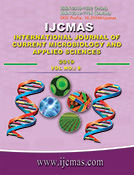


 National Academy of Agricultural Sciences (NAAS)
National Academy of Agricultural Sciences (NAAS)

|
PRINT ISSN : 2319-7692
Online ISSN : 2319-7706 Issues : 12 per year Publisher : Excellent Publishers Email : editorijcmas@gmail.com / submit@ijcmas.com Editor-in-chief: Dr.M.Prakash Index Copernicus ICV 2018: 95.39 NAAS RATING 2020: 5.38 |
Antifungal activity of lactic acid bacteria in food preservation is one of the technological properties sought. The antifungal effect of lactic acid bacteria has been studied. Four strains namely Lactobacillus plantarum G100, Lactobacillus brevis L62, Lactobacillus rhamnosus THT and Pediococcus pentosaceus Hela showed inhibitory activity against Tricoderma F14, Penicillium canescens 10-10 C, Aspergillus niger and Rhyzopus stoloniferous. Antifungal activity of L. rhamnosus THT strain depended mostly on the presence of these organic acids. L. brevis L62 and P. pentosaceus Hela strains depended on the production of hydrogen peroxide, especially in acidic media. Lactobacillus plantarum G100 still remains insensitive to the action of hydrogen peroxide, but its antagonism effect was reduced after subjecting its supernatant to a protease treatment at this same pH of 7. L. plantarum G100 activity could be ascribe to the presence of peptide compounds as well as that of organic acids. The inhibitory effect was even higher when the pH of the medium was between 3 and 4.5. Loss of this activity was remarked when pH was above 6. Lastly, whatever the nature of the metabolites secreted into the culture medium, their activities remained effective when the pH was acidic and quite similar to the pH observed at the end of the culture period.
 |
 |
 |
 |
 |